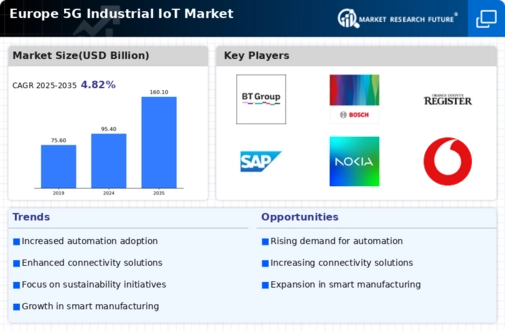Emergence of Edge Computing Solutions
The rise of edge computing solutions is poised to have a profound impact on the 5g industrial-iot market in Europe. By processing data closer to the source, edge computing reduces latency and bandwidth usage, which is particularly beneficial for applications requiring real-time analytics. This technology complements the capabilities of 5G networks, enabling industries to deploy IoT devices that can operate efficiently in remote or challenging environments. As organizations increasingly adopt edge computing, the demand for integrated solutions that combine 5G connectivity with edge processing is expected to grow. Analysts suggest that by 2027, edge computing could account for nearly 25% of the overall market in the 5g industrial-iot sector, highlighting its potential to transform operational paradigms across various industries.
Increased Focus on Automation and Robotics
The 5g industrial-iot market in Europe is witnessing a marked increase in the focus on automation and robotics. As industries seek to optimize production processes and reduce labor costs, the integration of automated systems powered by 5G technology is becoming more prevalent. This shift is particularly relevant in manufacturing, where robotics can enhance precision and efficiency. Recent studies indicate that the adoption of automation technologies could lead to a productivity increase of up to 40% in certain sectors. Furthermore, the low latency and high bandwidth capabilities of 5G networks facilitate seamless communication between machines, enabling more sophisticated automation solutions. Consequently, the growing emphasis on automation is likely to propel the 5g industrial-iot market forward, as businesses invest in advanced technologies to remain competitive in an evolving landscape.
Rising Demand for Real-Time Data Processing
The 5g industrial-iot market in Europe is experiencing a notable surge in demand for real-time data processing capabilities. Industries are increasingly reliant on instantaneous data analytics to enhance operational efficiency and decision-making processes. This trend is particularly evident in sectors such as manufacturing and logistics, where the ability to process data in real-time can lead to significant cost savings and productivity improvements. According to recent estimates, the integration of 5G technology could potentially reduce latency by up to 90%, thereby facilitating faster response times and more agile operations. As businesses strive to remain competitive, the need for advanced data processing solutions is likely to drive further investments in the 5g industrial-iot market, positioning it as a critical enabler of Industry 4.0 initiatives across Europe.
Expansion of Smart Infrastructure Initiatives
The development of smart infrastructure initiatives across Europe is significantly influencing the 5g industrial-iot market. Governments and private entities are investing heavily in smart city projects, which integrate IoT devices and 5G connectivity to improve urban living conditions. These initiatives aim to enhance public services, reduce energy consumption, and improve transportation systems. For instance, the European Commission has allocated substantial funding to support the deployment of smart grids and intelligent transportation systems. This investment is expected to create a robust ecosystem for the 5g industrial-iot market, as the demand for interconnected devices and systems continues to grow. By 2026, it is projected that smart infrastructure could account for over 30% of the total market share in the 5g industrial-iot sector, underscoring its importance in driving technological advancements.
Growing Regulatory Support for Digital Transformation
Regulatory support for digital transformation initiatives is becoming a key driver for the 5g industrial-iot market in Europe. Governments are implementing policies that encourage the adoption of advanced technologies, including 5G and IoT, to enhance industrial competitiveness and innovation. For example, the European Union has introduced frameworks aimed at fostering digitalization across various sectors, which includes funding for research and development in 5G applications. This regulatory environment is likely to stimulate investments in the 5g industrial-iot market, as businesses seek to align with governmental objectives and leverage available resources. As a result, the interplay between regulatory support and market dynamics may lead to accelerated growth in the adoption of 5G technologies, positioning Europe as a leader in the industrial IoT landscape.

















Leave a Comment